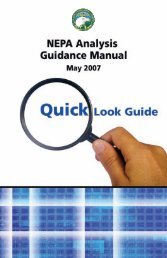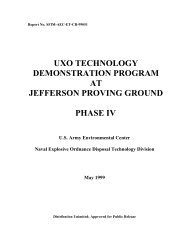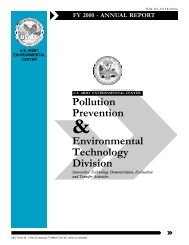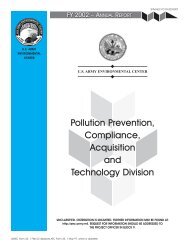(MRAP) Vehicle Program - U.S. Army Environmental Center
(MRAP) Vehicle Program - U.S. Army Environmental Center
(MRAP) Vehicle Program - U.S. Army Environmental Center
Create successful ePaper yourself
Turn your PDF publications into a flip-book with our unique Google optimized e-Paper software.
<strong>Army</strong> <strong>MRAP</strong> <strong>Vehicle</strong> <strong>Program</strong> <strong>Program</strong>matic <strong>Environmental</strong> Assessment December 2010<br />
Soil resources include the soils and minerals that overlay bedrock and other parent<br />
material. Soils can be defined in terms of their complex types and physical<br />
characteristics. Each installation and facility associated with the <strong>MRAP</strong> <strong>Program</strong> has its<br />
unique soil resources. Likewise, the installations have programs and spill prevention<br />
and containment plans that reduce or eliminate impacts to the local soil resources.<br />
Land use can be identified as the planned development of property to achieve the<br />
highest and best use of the land. In addition, land use planning should occur to ensure<br />
usage compatibility with the surrounding land. Installations that are involved with the<br />
<strong>MRAP</strong> <strong>Program</strong> have land use plans to address the aforementioned land development<br />
and usage.<br />
Several Federal Regulations and Acts define cultural resources. The National Historic<br />
Preservation Act identifies historic properties and the Native American Graves<br />
Protection and Repatriation Act of 1990 lists cultural items as cultural resources. The<br />
Archeological Resource Protection Act of 1979 defines archaeological resources as<br />
cultural resources. Facilities and installations must comply with the previously listed<br />
acts.<br />
Air quality refers to the amount of air pollution within an area. Within the United<br />
States, the Clean Air Act (CAA) has historically regulated air pollution sources. The CAA’s<br />
objectives are to protect and enhance the quality of the nation’s air resources. The CAA<br />
also establishes a required ambient air quality level set by the National Ambient Air<br />
Quality Standards (NAAQS). The NAAQS consists of primary and secondary standards<br />
for six criteria air pollutants: sulfur dioxide, nitrogen dioxide, carbon monoxide, ozone,<br />
lead and particulate matter. Individual states have the authority to establish emission<br />
source requirements to achieve attainment of the NAAQS. The CAA also establishes the<br />
requirements and standards to control other air pollution problems. This includes<br />
standards for Hazardous Air Pollutants (HAPs), an acid rain reduction program, and a<br />
program to phase out the manufacture and use of Ozone Depleting Chemicals (ODCs).<br />
The facilities and military installations involved with the <strong>MRAP</strong> <strong>Program</strong> are required to<br />
comply with the CAA standards and requirements.<br />
Similar to air quality, water quality refers to the amount of water pollution. For this<br />
PEA, water can include surface water (lakes, rivers, streams), groundwater (subsurface<br />
hydrologic areas such as aquifers), and storm water (water from impervious surfaces<br />
such as roads, buildings, etc). The activities associated with the <strong>MRAP</strong> program must<br />
comply with the Clean Water Act (CWA). The CWA regulates activities involving the<br />
collection and discharge of water borne pollutants and construction activities near<br />
waterways and wetlands.<br />
Noise is generally defined as an unwanted sound. This could include a sound that occurs<br />
at a level that causes human hearing damage, is annoying in nature, or interferes with<br />
human communication. Military noise consists of noise from vehicle, equipment, and<br />
tool operation, high‐amplitude noise from artillery and armor firing, and noise from<br />
UNCLASSIFIED 22







